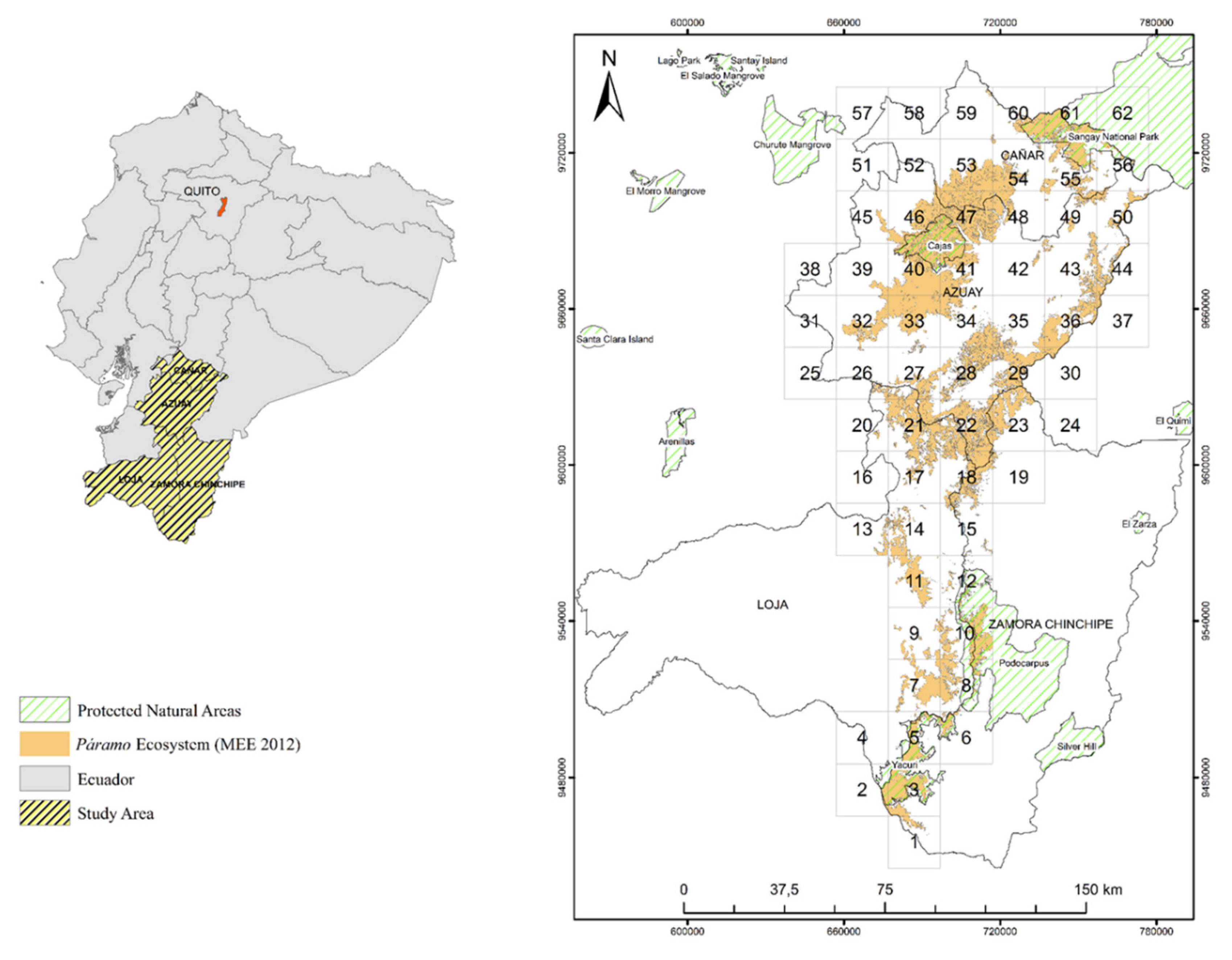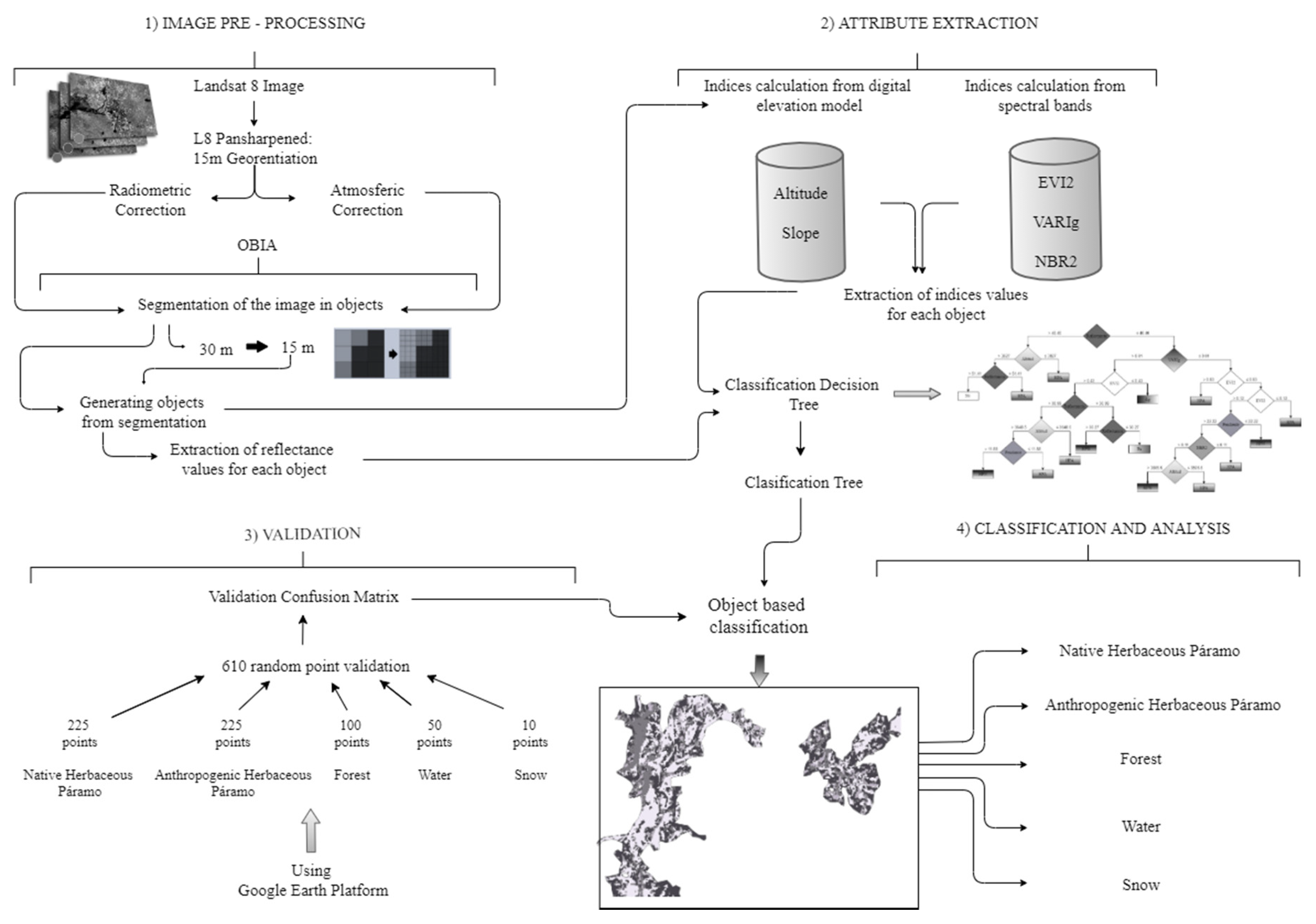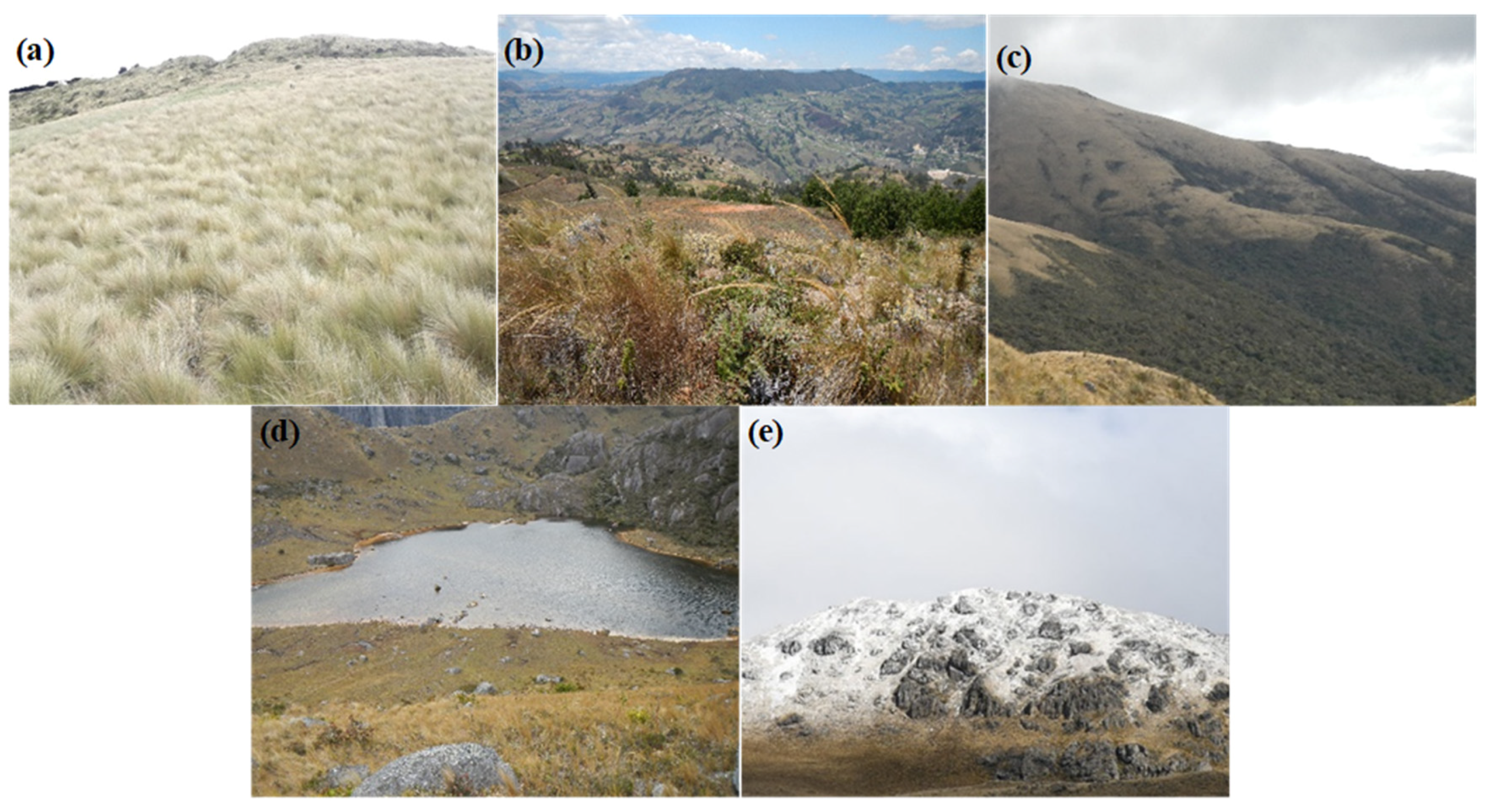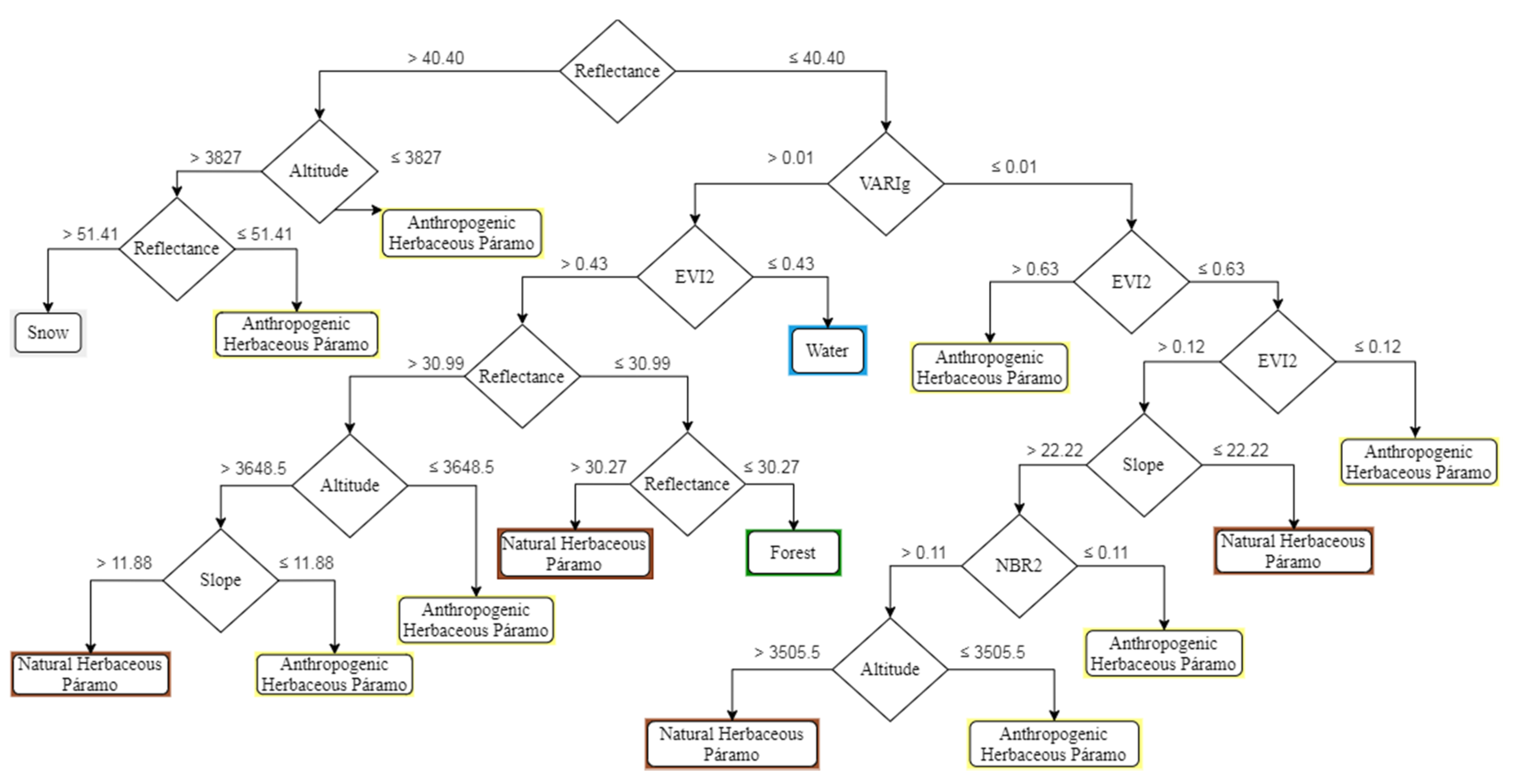Páramo Ecosystems in Ecuador’s Southern Region: Conservation State and Restoration
Abstract
1. Introduction
2. Materials and Methods
2.1. Area of Study
2.2. The Herbaceous Páramo
2.3. Workflow
2.4. Landsat-8 Images
2.5. Categorization of Land Use and Land Cover
2.6. Object-Based Image Analysis
2.7. Predictor Variables
2.8. Decision Tree
2.9. Validation of the Classification Decision Tree
3. Results
4. Discussion
5. Conclusions
Author Contributions
Funding
Acknowledgments
Conflicts of Interest
References
- Acevedo, C.; Alarcon, L.; Miranda-Esquivel, D. Páramos Neotropicales como unidades biogeográficas. Biol. Trop. 2020, 68, 503–516. [Google Scholar]
- Hofstede, R.; Calles, J.; López, V. Los Páramos Andinos Qué Sabemos? Estado de Conocimiento Sobre el Impacto del Cambio Climático en el Ecosistema Páramo. 2014. Available online: https://portals.iucn.org/library/node/44760 (accessed on 17 July 2018).
- Poulenard, J.; Podwojewski, P.; Janeau, J.-L.; Collinet, J. Runoff and soil erosion under rainfall simulation of Andisols from the Ecuadorian Páramo: Effect of tillage and burning. Catena 2001, 45, 185–207. [Google Scholar] [CrossRef]
- López, S.; López-Sandoval, M.F.; Gerique, A.; Salazar, J. Landscape change in Southern Ecuador: An indicator-based and multi-temporal evaluation of land use and land cover in a mixed-use protected area. Ecol. Indic. 2020, 115, 106357. [Google Scholar] [CrossRef]
- Calderón-Loor, M.; Cuesta, F.; Pinto, E.; Gosling, W.D. Carbon sequestration rates indicate ecosystem recovery following human disturbance in the equatorial Andes. PLoS ONE 2020, 15, e0230612. [Google Scholar] [CrossRef]
- Binder, S.; Isbell, F.; Polasky, S.; Catford, J.A.; Tilman, D. Grassland biodiversity can pay. Proc. Natl. Acad. Sci. USA 2018, 115, 3876–3881. [Google Scholar] [CrossRef] [PubMed]
- Nerlekar, A.N.; Veldman, J.W. High plant diversity and slow assembly of old-growth grasslands. Proc. Natl. Acad. Sci. USA 2020, 117, 18550–18556. [Google Scholar] [CrossRef] [PubMed]
- García, V.J.; Márquez, C.O.; Isenhart, T.M.; Rodríguez, M.; Crespo, S.D.; Cifuentes, A.G. Evaluating the conservation state of the páramo ecosystem: An object-based image analysis and CART algorithm approach for central Ecuador. Heliyon 2019, 5, e02701. [Google Scholar] [CrossRef] [PubMed]
- Joslin, A.J.; Jepson, W.E. Territory and authority of water fund payments for ecosystem services in Ecuador’s Andes. Geoforum 2018, 91, 10–20. [Google Scholar] [CrossRef]
- Barta, B.; Mouillet, C.; Espinosa, R.; Andino, P.; Jacobsen, D.; Christoffersen, K.S. Glacial-fed and páramo lake ecosystems in the tropical high Andes. Hydrobiologia 2017, 813, 19–32. [Google Scholar] [CrossRef]
- Madriñán, S.; Cortés, A.J.; Richardson, J.E. Páramo is the world’s fastest evolving and coolest biodiversity hotspot. Front. Genet. 2013, 4, 192. [Google Scholar] [CrossRef]
- Ayala-Izurieta, J.E.; Márquez, C.O.; García, V.J.; Recalde, C.; Llerena, M.V.R.; Damián-Carrión, D.A. Land Cover Classification in an Ecuadorian Mountain Geosystem Using a Random Forest Classifier, Spectral Vegetation Indices, and Ancillary Geographic Data. Geoscience 2017, 7, 34. [Google Scholar] [CrossRef]
- Prat, C. The Soils of Ecuador. In World Soils Book Series; Springer Science and Business Media LLC.: Berlin, Germany, 2018; pp. 11–49. [Google Scholar]
- Hribljan, J.A.; Suárez, E.R.; Heckman, K.A.; Lilleskov, E.A.; Chimner, R.A. Peatland carbon stocks and accumulation rates in the Ecuadorian páramo. Wetl. Ecol. Manag. 2016, 24, 113–127. [Google Scholar] [CrossRef]
- Wiesmeier, M.; Hübner, R.; Barthold, F.K.; Spörlein, P.; Geuß, U.; Hangen, E.; Reischl, A.; Schilling, B.; Von Lützow, M.; Kögel-Knabner, I. Amount, distribution and driving factors of soil organic carbon and nitrogen in cropland and grassland soils of southeast Germany (Bavaria). Agric. Ecosyst. Environ. 2013, 176, 39–52. [Google Scholar] [CrossRef]
- Chenot, J.; Jaunatre, R.; Buisson, E.; Bureau, F.; Dutoit, T. Impact of quarry exploitation and disuse on pedogenesis. Catena 2018, 160, 354–365. [Google Scholar] [CrossRef]
- Carrillo-Rojas, G.; Silva, B.; Rollenbeck, R.; Célleri, R.; Bendix, J. The breathing of the Andean highlands: Net ecosystem exchange and evapotranspiration over the páramo of southern Ecuador. Agric. For. Meteorol. 2019, 265, 30–47. [Google Scholar] [CrossRef]
- Buytaert, W.; Sevink, J.; De Leeuw, B.; Deckers, J. Clay mineralogy of the soils in the south Ecuadorian páramo region. Geoderma 2005, 127, 114–129. [Google Scholar] [CrossRef]
- Rivera, J.I.; Bonilla, C.A. Predicting soil aggregate stability using readily available soil properties and machine learning techniques. Catena 2020, 187, 104408. [Google Scholar] [CrossRef]
- Ministerio del Ambiente del Ecuador. Sistema de Clasificación de los Ecosistemas del Ecuador Continental; Subsecretaría de Patrinmonio Natural: Quito, Ecuador, 2013.
- Saldarriaga, J.C.; Hoyo, D.Á.; Correa, M.Á. Evaluación De Procesos Biológicos Unitarios En La Remoción Simultánea De Nutrientes Para Minimizar La Eutrofización. DialnetUniriojaEs 2011, 15, 129–140. [Google Scholar]
- Severino, G.; De Bartolo, S.; Toraldo, G.; Srinivasan, G.; Viswanathan, H. Water Resources Research. Water Resour. Res. 2012, 53, 5998–6017. [Google Scholar]
- Ministerio del Ambiente del Ecuador. Metodología Para la Representación Cartográfica de los Ecossitemas del Ecuador Continental; Subsecretaría de Patrimonio Natural: Quito, Ecuador, 2012.
- Instituto Geográfico Militar. Instituto Geográfico Militar. Available online: http://www.igm.gob.ec/cms/files/cartabase/enie/ENIEV_C2.htm (accessed on 15 December 2013).
- Urbanski, J. Integration of GEOBIA with GIS for semi-automatic land cover mapping from Landsat 8 imagery. In Proceedings of the 5th GEOBIA conference, Thessaloniki, Poland, 21–24 May 2014. [Google Scholar]
- Yengoh, G.T.; Dent, D.; Olsson, L.; Tengberg, A.; Iii, C.J.T. The Use of the Normalized Difference Vegetation Index (NDVI) to Assess Land Degradation at Multiple Scales: Current Status, Future Trends, and Practical Considerations; Springer: New York, NY, USA, 2015. [Google Scholar]
- Gitelson, A.A.; Kaufman, Y.J.; Stark, R.; Rundquist, D. Novel algorithms for remote estimation of vegetation fraction. Remote. Sens. Environ. 2002, 80, 76–87. [Google Scholar] [CrossRef]
- Jiang, Z.; Huete, A.; Didan, K.; Miura, T. Development of a two-band enhanced vegetation index without a blue band. Remote Sens. Environ. 2008, 112, 3833–3845. [Google Scholar] [CrossRef]
- Storey, E.A.; Stow, D.A.; O’Leary, J.F. Assessing postfire recovery of chamise chaparral using multi-temporal spectral vegetation index trajectories derived from Landsat imagery. Remote Sens. Environ. 2016, 183, 53–64. [Google Scholar] [CrossRef]
- Nemmaoui, A.; Aguilar, M.A.; Aguilar, F.J.; Novelli, A.; Lorca, A.M.G. Greenhouse Crop Identification from Multi-Temporal Multi-Sensor Satellite Imagery Using Object-Based Approach: A Case Study from Almería (Spain). Remote. Sens. 2018, 10, 1751. [Google Scholar] [CrossRef]
- Cao, J.; Leng, W.; Liu, K.; Liu, L.; He, Z.; Zhu, Y. Object-Based Mangrove Species Classification Using Unmanned Aerial Vehicle Hyperspectral Images and Digital Surface Models. Remote Sens. 2018, 10, 89. [Google Scholar] [CrossRef]
- Dahik, C.Q.; Marín, F.; Arias, R.; Crespo, P.J.; Weber, M.; Palomeque, X. Comparison of Natural Regeneration in Natural Grassland and Pine Plantations across an Elevational Gradient in the Páramo Ecosystem of Southern Ecuador. Forests 2019, 10, 745. [Google Scholar] [CrossRef]
- Llambí, L.D.; Teresa, M.; Independiente, B. Building a Strategy for the Integrated Monitoring of High Mountain Ecosystems in Colombia. Biodivers Práctica 2019, 4, 150–172. [Google Scholar]
- Sarmiento, C.; Osejo, A.; Ungar, P. Páramos habitados: Desafíos para la gobernanza ambiental de la alta montaña en Colombia. Biodivers Práctica 2017, 2, 122–145. [Google Scholar]
- Wiesmeier, M.; Urbanski, L.; Hobley, E. Páramos Neotropicales como unidades biogeográficas. Glob. Chang. Biol. 2019, 54, 651–661. [Google Scholar]
- Gutiérrez-Salazar, P.; Medrano-Vizcaíno, P. The effects of climate change on decomposition processes in andean paramo ecosystem–synthesis, a systematic review. Appl. Ecol. Environ. Res. 2019, 17, 4957–4970. [Google Scholar] [CrossRef]






| Object Features | Description | |
|---|---|---|
| Reflectance basic spectral information (Landsat 8 bands B2, B3, B4, and B8). | The average of the ground REFLECTANCE values at the bottom of the atmosphere for all pixels within an object. | |
| Spectral vegetation indexes derived from Landsat 8 B2, B3, B4, B5, B6, and B7 bands. | EVI2, VARIg, y NBR2. | |
| Topographic indexes derived from DEM. | ALTITUDE y SLOPE. | |
| Spectral vegetation indexes derived from Landsat 8 bands B2, B3, B4, B5, B6, and B7. | ||
| Index | Formulation | Description |
| VARIg: Visible Atmospherically Resistant Vegetation Index Green. | Lineally sensitive to vegetation fraction, it exhibits a good correlation with nitrogen contents [27]. | |
| EVI2: Enhanced Vegetation Index 2 | Provide greater sensitivity in regions with high biomass while minimizing the soil’s influence and atmosphere [28]. | |
| NBR2: Normalized Burn Ratio 2 | NBR2 is useful for the postfire recovery assessment [29]. | |
| Clase Predict | |||||
|---|---|---|---|---|---|
| Current Class ↓ | Water (50) | Forest (100) | Native Herbaceous páramo (225) | Anthropogenic Herbaceous páramo (225) | Snow (10) |
| Water (35) | 35 | 0 | 0 | 0 | 0 |
| Forest (98) | 2 | 88 | 0 | 8 | 0 |
| Native herbaceous páramo (254) | 5 | 12 | 221 | 15 | 1 |
| Anthropogenic herbaceous páramo (215) | 8 | 0 | 4 | 202 | 1 |
| Snow (8) | 0 | 0 | 0 | 0 | 8 |
| Water | Forest | Native Herbaceous páramo | Anthropogenic Herbaceous páramo | Snow | |
|---|---|---|---|---|---|
| Sensitivity (User accuracy) | 1.00 | 0.90 | 0.87 | 0.94 | 1.00 |
| Specificity | 0.97 | 0.98 | 0.99 | 0.94 | 1.00 |
| Presicion (Producer accuracy) | 0.70 | 0.88 | 0.98 | 0.90 | 0.80 |
| Accuracy (Overall accuracy) | 0.98 | 0.96 | 0.94 | 0.94 | 1.00 |
| Misclassification rate | 0.02 | 0.04 | 0.06 | 0.06 | 0.00 |
| Informedness | 0.97 | 0.87 | 0.86 | 0.88 | 1.00 |
| Markedness | 0.70 | 0.86 | 0.90 | 0.86 | 0.80 |
| Matthew’s correlation | 0.84 | 0.87 | 0.84 | 0.88 | 0.89 |
| Region | Coordinates UTM—Zone 17 Southern Hemisphere | Surface Area (ha) | ||||||
|---|---|---|---|---|---|---|---|---|
| Native Herbaceous páramo (MEE 2012) | Native Herbaceous páramo | Anthropogenic Herbaceous páramo | Forest | Water | Snow | |||
| X | Y | |||||||
| 1 | 687030 | 9455278 | 0 | 42 | 201 | 213 | 55 | 0 |
| 2 | 667030 | 9475278 | 0 | 702 | 900 | 702 | 205 | 0 |
| 3 | 687030 | 9475278 | 0 | 837 | 2962 | 3204 | 1157 | 0 |
| 4 | 667030 | 9495278 | 0 | 0 | 0 | 0 | 0 | 0 |
| 5 | 687030 | 9495278 | 94 | 1363 | 4304 | 3196 | 793 | 0 |
| 6 | 707030 | 9495278 | 0 | 133 | 725 | 892 | 241 | 0 |
| 7 | 687030 | 9515278 | 534 | 53 | 167 | 167 | 74 | 0 |
| 8 | 70,030 | 9515278 | 3 | 46 | 360 | 307 | 21 | 0 |
| 9 | 687030 | 9535278 | 0 | 0 | 0 | 0 | 0 | 0 |
| 10 | 707030 | 9535278 | 0 | 517 | 1719 | 1829 | 579 | 0 |
| 11 | 687030 | 9555278 | 0 | 0 | 0 | 0 | 0 | 0 |
| 12 | 707030 | 9555278 | 1021 | 0 | 0 | 0 | 0 | 0 |
| 13 | 667030 | 9575278 | 0 | 0 | 0 | 0 | 0 | 0 |
| 14 | 687030 | 9575278 | 1507 | 12 | 369 | 9 | 18 | 0 |
| 15 | 707030 | 9575278 | 1681 | 21 | 288 | 175 | 16 | 0 |
| 16 | 667030 | 9595278 | 0 | 540 | 413 | 152 | 68 | 0 |
| 17 | 687030 | 9595278 | 254 | 3295 | 6217 | 1631 | 835 | 0 |
| 18 | 707030 | 9595278 | 16,142 | 1527 | 10,505 | 3695 | 1149 | 0 |
| 19 | 727030 | 9595278 | 559 | 34 | 250 | 413 | 21 | 0 |
| 20 | 667030 | 9615278 | 375 | 857 | 1665 | 394 | 84 | 0 |
| 21 | 687030 | 9615278 | 135 | 134 | 165 | 59 | 69 | 0 |
| 22 | 707030 | 9615278 | 9448 | 690 | 8421 | 4748 | 3210 | 0 |
| 23 | 727030 | 9615278 | 9225 | 1366 | 5080 | 4151 | 916 | 0 |
| 24 | 747030 | 9615278 | 7 | 0 | 0 | 8 | 0 | 0 |
| 25 | 647030 | 9635278 | 0 | 0 | 0 | 0 | 0 | 0 |
| 26 | 667030 | 9635278 | 108 | 0 | 0 | 0 | 0 | 0 |
| 27 | 687030 | 9635278 | 11 | 0 | 0 | 0 | 0 | 0 |
| 28 | 707030 | 9635278 | 8010 | 273 | 5852 | 1019 | 564 | 0 |
| 29 | 727030 | 9635278 | 17,629 | 2594 | 6117 | 5152 | 1690 | 0 |
| 30 | 747030 | 9635278 | 1557 | 213 | 755 | 386 | 306 | 0 |
| 31 | 647030 | 9655278 | 0 | 2 | 290 | 35 | 33 | 0 |
| 32 | 667030 | 9655278 | 9624 | 2678 | 7234 | 1333 | 813 | 0 |
| 33 | 687030 | 9655278 | 19,220 | 13,606 | 6426 | 1029 | 337 | 6 |
| 34 | 707030 | 9655278 | 8082 | 4121 | 3623 | 1754 | 131 | 0 |
| 35 | 727030 | 9655278 | 3703 | 396 | 2559 | 965 | 320 | 0 |
| 36 | 747030 | 9655278 | 11,073 | 2574 | 4753 | 3499 | 2092 | 0 |
| 37 | 767030 | 9655278 | 596 | 194 | 34 | 367 | 181 | 0 |
| 38 | 647030 | 9675278 | 0 | 0 | 0 | 0 | 0 | 0 |
| 39 | 667030 | 9675278 | 1758 | 1 | 4852 | 0 | 53 | 248 |
| 40 | 687030 | 9675278 | 26,464 | 18,374 | 12,431 | 1590 | 2793 | 41 |
| 41 | 707030 | 9675278 | 17,643 | 13,526 | 3639 | 3390 | 884 | 0 |
| 42 | 727030 | 9675278 | 0 | 0 | 0 | 0 | 0 | 0 |
| 43 | 747030 | 9675278 | 4967 | 487 | 937 | 1255 | 422 | 0 |
| 44 | 767030 | 9675278 | 4943 | 137 | 277 | 344 | 138 | 0 |
| 45 | 667030 | 9695278 | 1505 | 165 | 668 | 212 | 507 | 0 |
| 46 | 687030 | 9695278 | 12,577 | 10,036 | 7085 | 984 | 2486 | 313 |
| 47 | 707030 | 9695278 | 29,114 | 27,377 | 4721 | 2760 | 1885 | 47 |
| 48 | 727030 | 9695278 | 8106 | 4167 | 2358 | 1256 | 212 | 0 |
| 49 | 747030 | 9695278 | 3927 | 764 | 1447 | 1061 | 83 | 0 |
| 50 | 767030 | 9695278 | 4038 | 373 | 255 | 357 | 69 | 0 |
| 51 | 667030 | 9715278 | 0 | 0 | 0 | 0 | 0 | 0 |
| 52 | 687030 | 9715278 | 575 | 6 | 233 | 13 | 49 | 0 |
| 53 | 707030 | 9715278 | 12,803 | 7631 | 5862 | 295 | 1219 | 41 |
| 54 | 727030 | 9715278 | 9896 | 7204 | 5372 | 542 | 442 | 3 |
| 55 | 747030 | 9715278 | 15,106 | 5627 | 7350 | 4780 | 489 | 0 |
| 56 | 767030 | 9715278 | 1709 | 916 | 234 | 621 | 60 | 0 |
| 57 | 667030 | 9735278 | 0 | 0 | 0 | 0 | 0 | 0 |
| 58 | 687030 | 9735278 | 0 | 0 | 0 | 0 | 0 | 0 |
| 59 | 707030 | 9735278 | 0 | 0 | 0 | 0 | 0 | 0 |
| 60 | 727030 | 9735278 | 7677 | 5279 | 2303 | 234 | 100 | 27 |
| 61 | 747030 | 9735278 | 12,732 | 8302 | 4222 | 190 | 35 | 0 |
| 62 | 767030 | 9735278 | 828 | 642 | 228 | 39 | 13 | 0 |
| Total | 296,964 | 149,834 | 146,829 | 61,404 | 27,916 | 726 | ||
Publisher’s Note: MDPI stays neutral with regard to jurisdictional claims in published maps and institutional affiliations. |
© 2020 by the authors. Licensee MDPI, Basel, Switzerland. This article is an open access article distributed under the terms and conditions of the Creative Commons Attribution (CC BY) license (http://creativecommons.org/licenses/by/4.0/).
Share and Cite
García, V.J.; Márquez, C.O.; Rodríguez, M.V.; Orozco, J.J.; Aguilar, C.D.; Ríos, A.C. Páramo Ecosystems in Ecuador’s Southern Region: Conservation State and Restoration. Agronomy 2020, 10, 1922. https://doi.org/10.3390/agronomy10121922
García VJ, Márquez CO, Rodríguez MV, Orozco JJ, Aguilar CD, Ríos AC. Páramo Ecosystems in Ecuador’s Southern Region: Conservation State and Restoration. Agronomy. 2020; 10(12):1922. https://doi.org/10.3390/agronomy10121922
Chicago/Turabian StyleGarcía, Víctor J., Carmen O. Márquez, Marco V. Rodríguez, Jonathan J. Orozco, Christian D. Aguilar, and Anita C. Ríos. 2020. "Páramo Ecosystems in Ecuador’s Southern Region: Conservation State and Restoration" Agronomy 10, no. 12: 1922. https://doi.org/10.3390/agronomy10121922
APA StyleGarcía, V. J., Márquez, C. O., Rodríguez, M. V., Orozco, J. J., Aguilar, C. D., & Ríos, A. C. (2020). Páramo Ecosystems in Ecuador’s Southern Region: Conservation State and Restoration. Agronomy, 10(12), 1922. https://doi.org/10.3390/agronomy10121922




